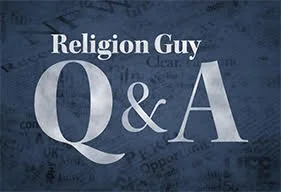THE QUESTION:
What is a religious "cult"
THE RELIGION GUY'S ANSWER:
On this somewhat delicate terrain, trusty Merriam-Webster offers us three definitions of "cult."
(1) A small religious group "not part of a larger and more accepted religion" with beliefs many regard as "extreme or dangerous."
(2) A situation with something or someone cared about "very much or too much," as in "a cult of personality."
(3) A small group of "very devoted supporters."
Note that the word can also depict well-recognized mainstream devotion, as when Catholics speak of the "cult of the Virgin."
The Guy proposes this definition: A marginal religious group we’re not supposed to like much or at all, which deviates from accepted practices or long-familiar beliefs, typically controlled by a dictatorial leader or leaders and often isolated from mainstream society.
Similarly from J. Gordon Melton of Baylor University, author of the essential "Encyclopedia of American Religions," who is not just an expert but highly tolerant toward America's countless offbeat religions. He has remarked that a cult is "a group that somebody doesn't like. It is a derogatory term"
Indeed it is derogatory. Undoubtedly some – but not all – groups considered to be cults have sinister track records; deceive outsiders; abuse their followers physically, psychologically, sexually, and/or financially; damage family and other relationships; and even resort to violence. The Guy says such allegations should be fairly pursued on the basis of secular criminal or civil law without judging whether a group's teachings measure up to some cultural standard. After all, the Constitution's Bill of Rights enshrines a religious freedom guarantee.
The U.S. Supreme Court famously settled this in its United States v. Ballard ruling of 1944. The case involved fraud convictions based upon the unconventional New Age beliefs of the "I Am" movement (still extant) and associates of its founder, the late Guy Ballard. He taught that "ascended masters" uniquely authorized him to transmit divine truth and to perform healings. In a 5-4 decision the Court stated, "The religious views espoused by respondents might seem incredible, if not preposterous, to most people," but the "truth or falsity" of a religion is no business of American government or courts to decide.
Merriam-Webster's phrase about separation from "a larger and more accepted" faith explains why a "cult" differs from the definition of a "sect," that is a direct offshoot from an established religion. Examples would be "Mormon" polygamist cells or snake-handling churches as opposed to mainstream Pentecostalism. "Sect" is not appropriate if the breakaway is sizable, for example 16th Century Protestantism when it left the Roman Catholic Church.
Due to religious rivalry and line-drawing, Protestant evangelicals often apply the "cult" label to, for instance, The Church of Jesus Christ of Latter-day Saints, not over any questionable practices but because its scriptures and beliefs as proclaimed in 19th Century America disagree with long centuries of mainstream, Trinitarian Christian teaching. Then again, there are cultish churches that teach perfectly orthodox Christian doctrines.
Journalists as aged as The Guy will well remember covering America's great cult scare of the 1970s, when emotions ranged from hostility to hysteria toward new, off-brand and unfamiliar faiths such as the Children of God, Church Universal and Triumphant, Hare Krishna, Love Israel Family, Rajneesh disciples, or Unification Church (a.k.a. "Moonies").
The era was somehow personified by Ted Patrick, a high school dropout hired by anxious families and friends to kidnap young converts and administer "deprogramming" to break the spiritual spell. Author Diane Benscoter, who was deprogrammed out of the Unification Church and worked as a deprogrammer herself, later founded antidote.ngo to replace such coercive tactics with counseling, education and outreach to counter groups said to practice "psychological manipulation."
Anti-cult fear reached an apogee in 1978 at Jonestown, an isolated jungle compound in Guyana, when 642 adult and 276 child followers of the Rev. Jim Jones died in a murder / suicide orgy. This atrocity mangled the usual "cult" criteria because Jones and his Peoples Temple, which originated in California, were credentialed and in good standing as affiliated with the "mainline" Christian Church (Disciples of Christ), itself a member of the thoroughly respectable National Council of Churches.
A subsequent upsurge of cult scares was sparked by tragedies like the federal raid in Texas during which 80 Branch Davidians burned to death (1993), 48 suicides in Switzerland's Solar Temple (1994), Aum Shinriko's three sarin gas attacks in Tokyo subways that indiscriminately murdered 13 travelers and injured thousands (1995), and the collective suicide of 39 Heaven's Gate devotees near San Diego (1997).
Precisely because fears about groups considered to be cults have been amply justified in these ways, academics and journalists should be very careful about labeling any group with such a slur.
The past four years, the cult sensation took a thoroughly secular turn with publicity about Keith Raniere's godlike grip on followers of his purported self-help sex cult (yes, "cult") NXIVM and perverse D.O.S. faction that branded its women. Fifteen victims testified when he was sentenced to 120 years in federal prison for racketeering and sex trafficking that included an underage girl. Among other places, the incredible story is told in the paperback and audiobook "Don't Call It a Cult" by Sarah Berman.
A five-age New Yorker article on that book last July by novelist Zoe Heller observed that even psychiatrists like Robert Lifton, a pioneer in studying mind control, downplay "brainwashing" as though converts to sinister groups are automatons.
CONTINUE READING: “What is a religious cult?”, by Richard Ostling.
FIRST IMAGE: Illustration for “What is a Cult?” feature at Inspired Walk website.


